Contemporary Issues in Accounting: AGL Energy Analysis
VerifiedAdded on 2023/06/09
|17
|2261
|331
Report
AI Summary
This report critically analyzes the financial reporting of AGL Energy Limited, evaluating its adherence to the conceptual framework of accounting. The report assesses whether AGL meets the objectives of general purpose financial reporting, providing relevant information for investors and resource contributors. It examines the recognition criteria for various financial statement elements, including assets, liabilities, expenses, and revenue, based on the AASB standards. Furthermore, the report explores both the fundamental and enhancing qualitative characteristics of financial reporting, such as relevance, faithfulness, timeliness, and understandability. The analysis utilizes AGL's annual report, providing evidence of compliance with accounting standards and offering recommendations for improved transparency and adherence to the conceptual framework.
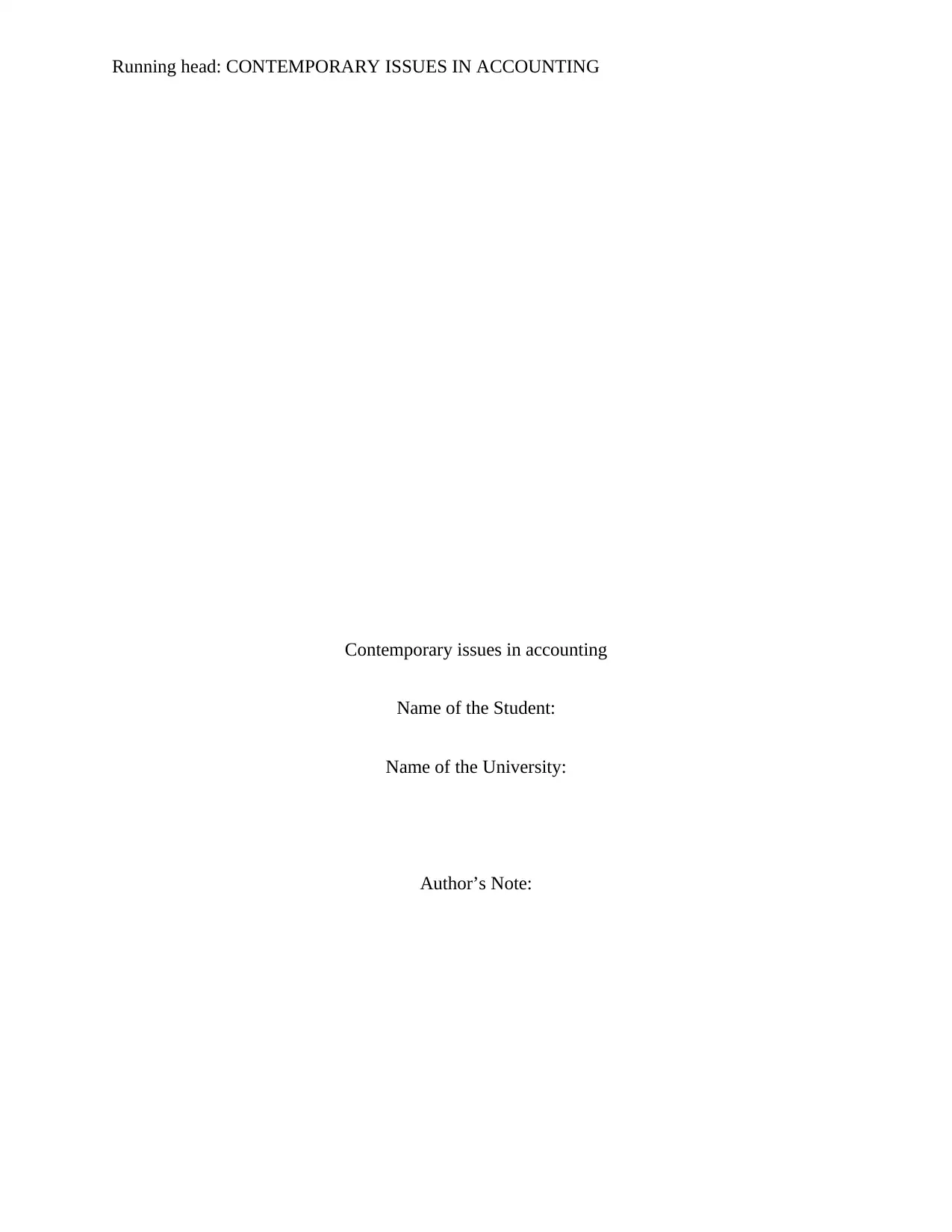
Running head: CONTEMPORARY ISSUES IN ACCOUNTING
Contemporary issues in accounting
Name of the Student:
Name of the University:
Author’s Note:
Contemporary issues in accounting
Name of the Student:
Name of the University:
Author’s Note:
Paraphrase This Document
Need a fresh take? Get an instant paraphrase of this document with our AI Paraphraser

1CONTEMPORARY ISSUES IN ACCOUNTING
Table of Contents
Introduction:....................................................................................................................................2
Discussion:.......................................................................................................................................2
Objectives of conceptual framework:..............................................................................................2
Recognition criteria:........................................................................................................................8
Fundamental qualitative characteristics of financial reporting:.....................................................13
Enhancing qualitative characteristics of financial reporting:........................................................13
Conclusion:....................................................................................................................................14
References list:...............................................................................................................................15
Table of Contents
Introduction:....................................................................................................................................2
Discussion:.......................................................................................................................................2
Objectives of conceptual framework:..............................................................................................2
Recognition criteria:........................................................................................................................8
Fundamental qualitative characteristics of financial reporting:.....................................................13
Enhancing qualitative characteristics of financial reporting:........................................................13
Conclusion:....................................................................................................................................14
References list:...............................................................................................................................15
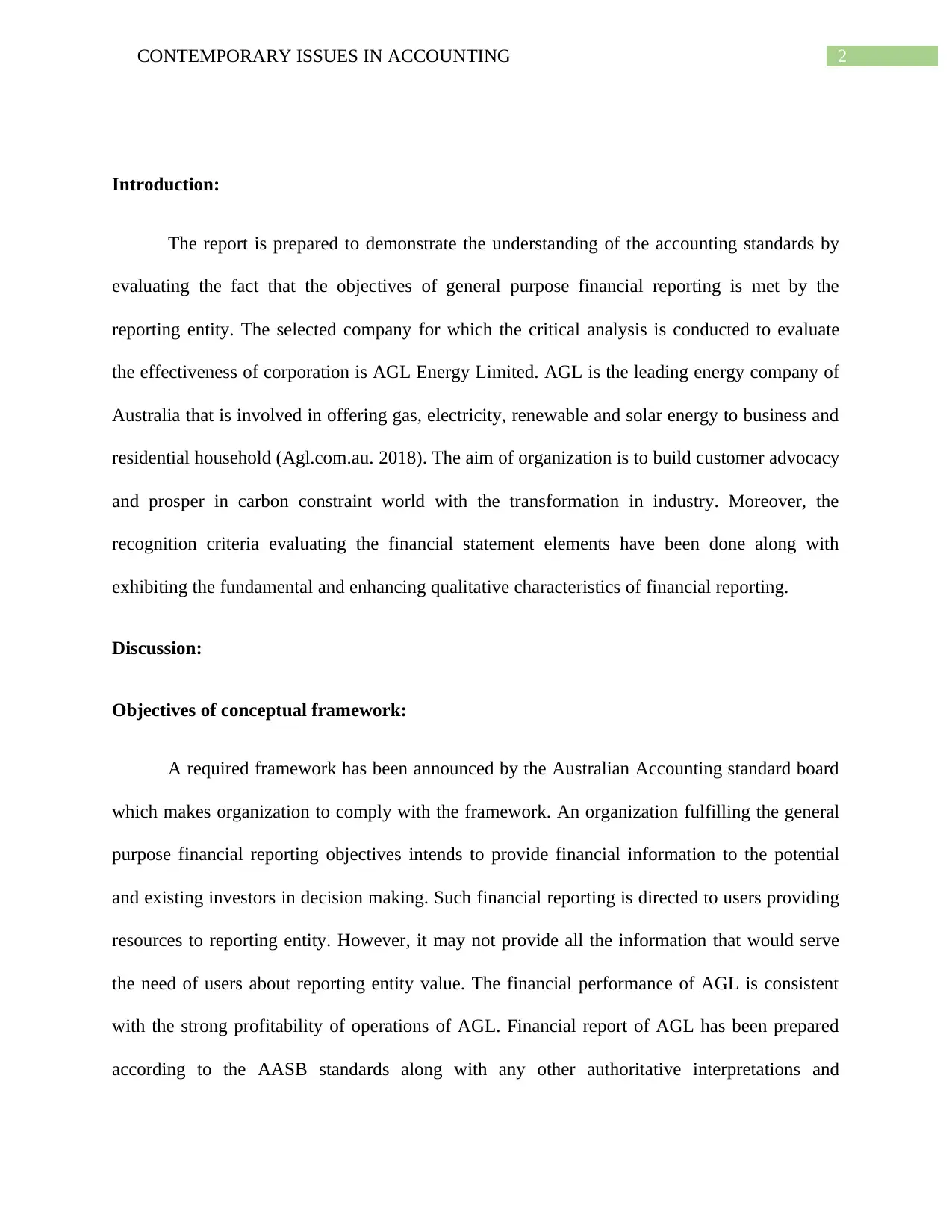
2CONTEMPORARY ISSUES IN ACCOUNTING
Introduction:
The report is prepared to demonstrate the understanding of the accounting standards by
evaluating the fact that the objectives of general purpose financial reporting is met by the
reporting entity. The selected company for which the critical analysis is conducted to evaluate
the effectiveness of corporation is AGL Energy Limited. AGL is the leading energy company of
Australia that is involved in offering gas, electricity, renewable and solar energy to business and
residential household (Agl.com.au. 2018). The aim of organization is to build customer advocacy
and prosper in carbon constraint world with the transformation in industry. Moreover, the
recognition criteria evaluating the financial statement elements have been done along with
exhibiting the fundamental and enhancing qualitative characteristics of financial reporting.
Discussion:
Objectives of conceptual framework:
A required framework has been announced by the Australian Accounting standard board
which makes organization to comply with the framework. An organization fulfilling the general
purpose financial reporting objectives intends to provide financial information to the potential
and existing investors in decision making. Such financial reporting is directed to users providing
resources to reporting entity. However, it may not provide all the information that would serve
the need of users about reporting entity value. The financial performance of AGL is consistent
with the strong profitability of operations of AGL. Financial report of AGL has been prepared
according to the AASB standards along with any other authoritative interpretations and
Introduction:
The report is prepared to demonstrate the understanding of the accounting standards by
evaluating the fact that the objectives of general purpose financial reporting is met by the
reporting entity. The selected company for which the critical analysis is conducted to evaluate
the effectiveness of corporation is AGL Energy Limited. AGL is the leading energy company of
Australia that is involved in offering gas, electricity, renewable and solar energy to business and
residential household (Agl.com.au. 2018). The aim of organization is to build customer advocacy
and prosper in carbon constraint world with the transformation in industry. Moreover, the
recognition criteria evaluating the financial statement elements have been done along with
exhibiting the fundamental and enhancing qualitative characteristics of financial reporting.
Discussion:
Objectives of conceptual framework:
A required framework has been announced by the Australian Accounting standard board
which makes organization to comply with the framework. An organization fulfilling the general
purpose financial reporting objectives intends to provide financial information to the potential
and existing investors in decision making. Such financial reporting is directed to users providing
resources to reporting entity. However, it may not provide all the information that would serve
the need of users about reporting entity value. The financial performance of AGL is consistent
with the strong profitability of operations of AGL. Financial report of AGL has been prepared
according to the AASB standards along with any other authoritative interpretations and
⊘ This is a preview!⊘
Do you want full access?
Subscribe today to unlock all pages.

Trusted by 1+ million students worldwide
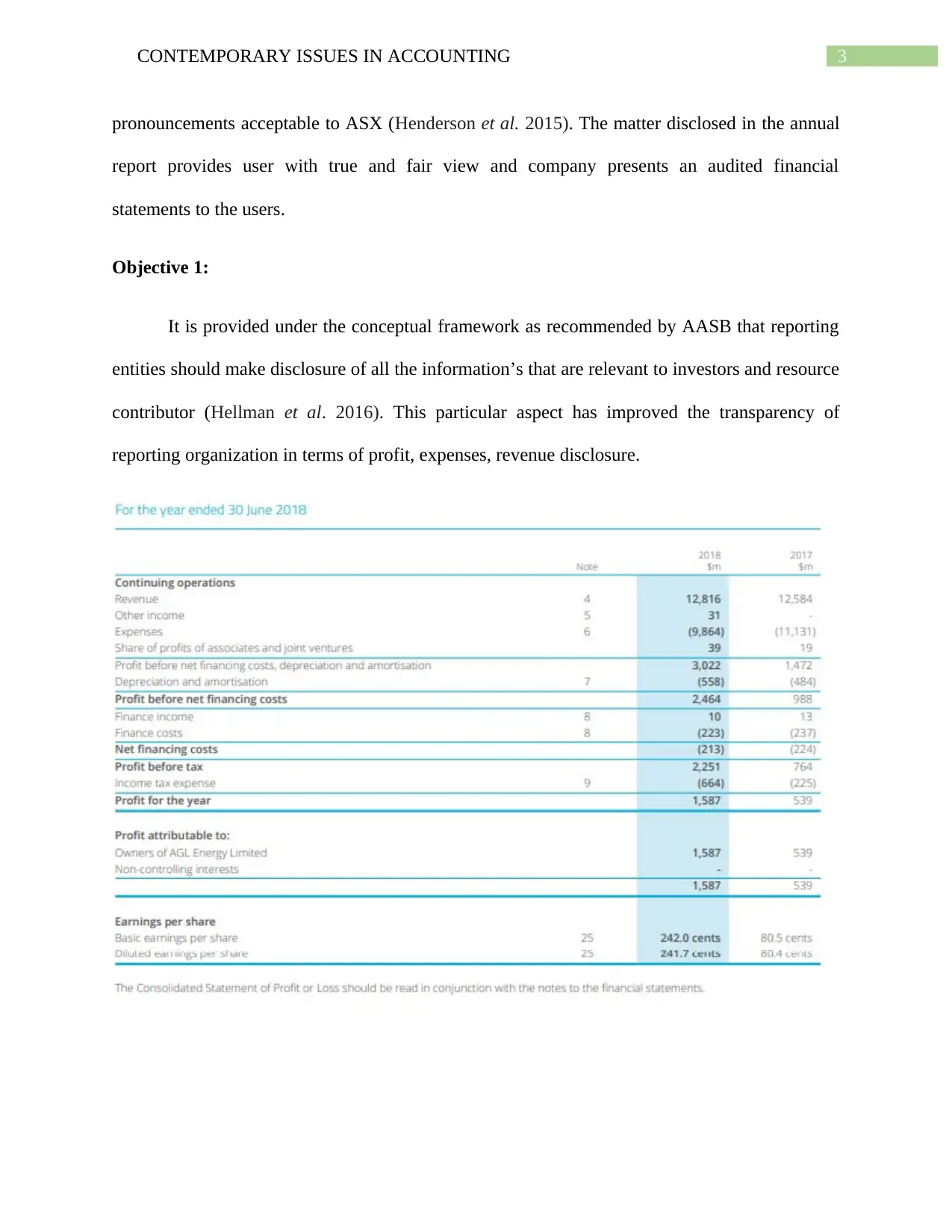
3CONTEMPORARY ISSUES IN ACCOUNTING
pronouncements acceptable to ASX (Henderson et al. 2015). The matter disclosed in the annual
report provides user with true and fair view and company presents an audited financial
statements to the users.
Objective 1:
It is provided under the conceptual framework as recommended by AASB that reporting
entities should make disclosure of all the information’s that are relevant to investors and resource
contributor (Hellman et al. 2016). This particular aspect has improved the transparency of
reporting organization in terms of profit, expenses, revenue disclosure.
pronouncements acceptable to ASX (Henderson et al. 2015). The matter disclosed in the annual
report provides user with true and fair view and company presents an audited financial
statements to the users.
Objective 1:
It is provided under the conceptual framework as recommended by AASB that reporting
entities should make disclosure of all the information’s that are relevant to investors and resource
contributor (Hellman et al. 2016). This particular aspect has improved the transparency of
reporting organization in terms of profit, expenses, revenue disclosure.
Paraphrase This Document
Need a fresh take? Get an instant paraphrase of this document with our AI Paraphraser
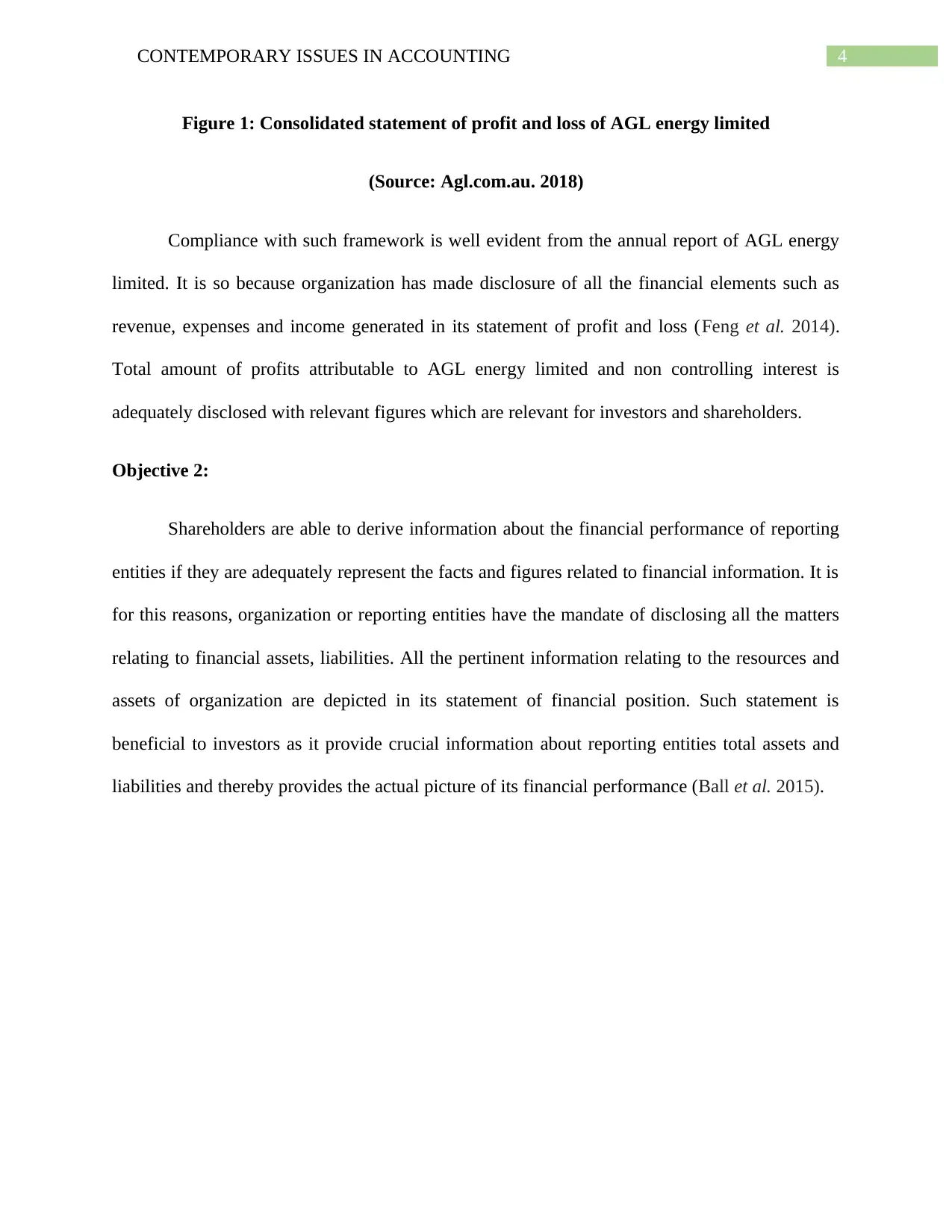
4CONTEMPORARY ISSUES IN ACCOUNTING
Figure 1: Consolidated statement of profit and loss of AGL energy limited
(Source: Agl.com.au. 2018)
Compliance with such framework is well evident from the annual report of AGL energy
limited. It is so because organization has made disclosure of all the financial elements such as
revenue, expenses and income generated in its statement of profit and loss (Feng et al. 2014).
Total amount of profits attributable to AGL energy limited and non controlling interest is
adequately disclosed with relevant figures which are relevant for investors and shareholders.
Objective 2:
Shareholders are able to derive information about the financial performance of reporting
entities if they are adequately represent the facts and figures related to financial information. It is
for this reasons, organization or reporting entities have the mandate of disclosing all the matters
relating to financial assets, liabilities. All the pertinent information relating to the resources and
assets of organization are depicted in its statement of financial position. Such statement is
beneficial to investors as it provide crucial information about reporting entities total assets and
liabilities and thereby provides the actual picture of its financial performance (Ball et al. 2015).
Figure 1: Consolidated statement of profit and loss of AGL energy limited
(Source: Agl.com.au. 2018)
Compliance with such framework is well evident from the annual report of AGL energy
limited. It is so because organization has made disclosure of all the financial elements such as
revenue, expenses and income generated in its statement of profit and loss (Feng et al. 2014).
Total amount of profits attributable to AGL energy limited and non controlling interest is
adequately disclosed with relevant figures which are relevant for investors and shareholders.
Objective 2:
Shareholders are able to derive information about the financial performance of reporting
entities if they are adequately represent the facts and figures related to financial information. It is
for this reasons, organization or reporting entities have the mandate of disclosing all the matters
relating to financial assets, liabilities. All the pertinent information relating to the resources and
assets of organization are depicted in its statement of financial position. Such statement is
beneficial to investors as it provide crucial information about reporting entities total assets and
liabilities and thereby provides the actual picture of its financial performance (Ball et al. 2015).
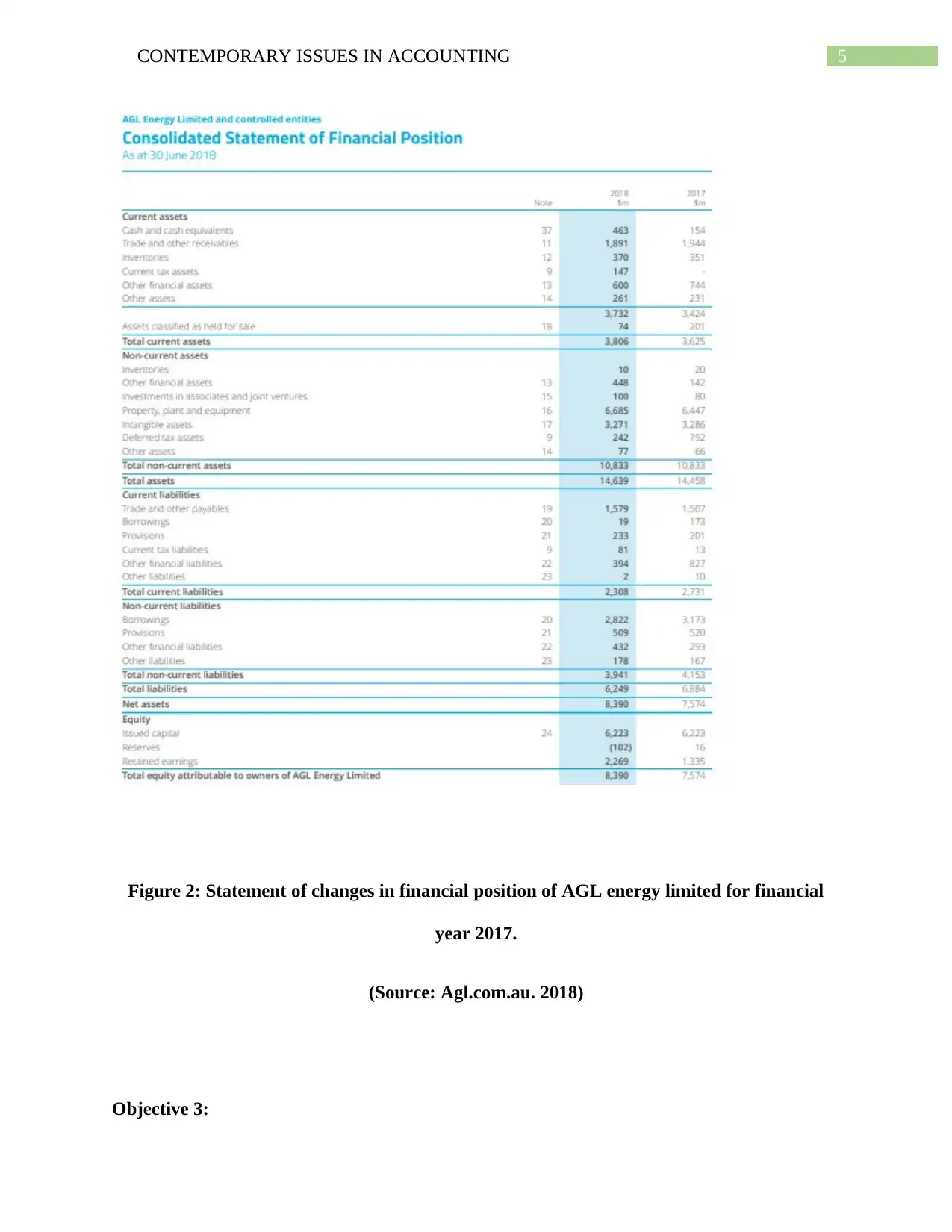
5CONTEMPORARY ISSUES IN ACCOUNTING
Figure 2: Statement of changes in financial position of AGL energy limited for financial
year 2017.
(Source: Agl.com.au. 2018)
Objective 3:
Figure 2: Statement of changes in financial position of AGL energy limited for financial
year 2017.
(Source: Agl.com.au. 2018)
Objective 3:
⊘ This is a preview!⊘
Do you want full access?
Subscribe today to unlock all pages.

Trusted by 1+ million students worldwide
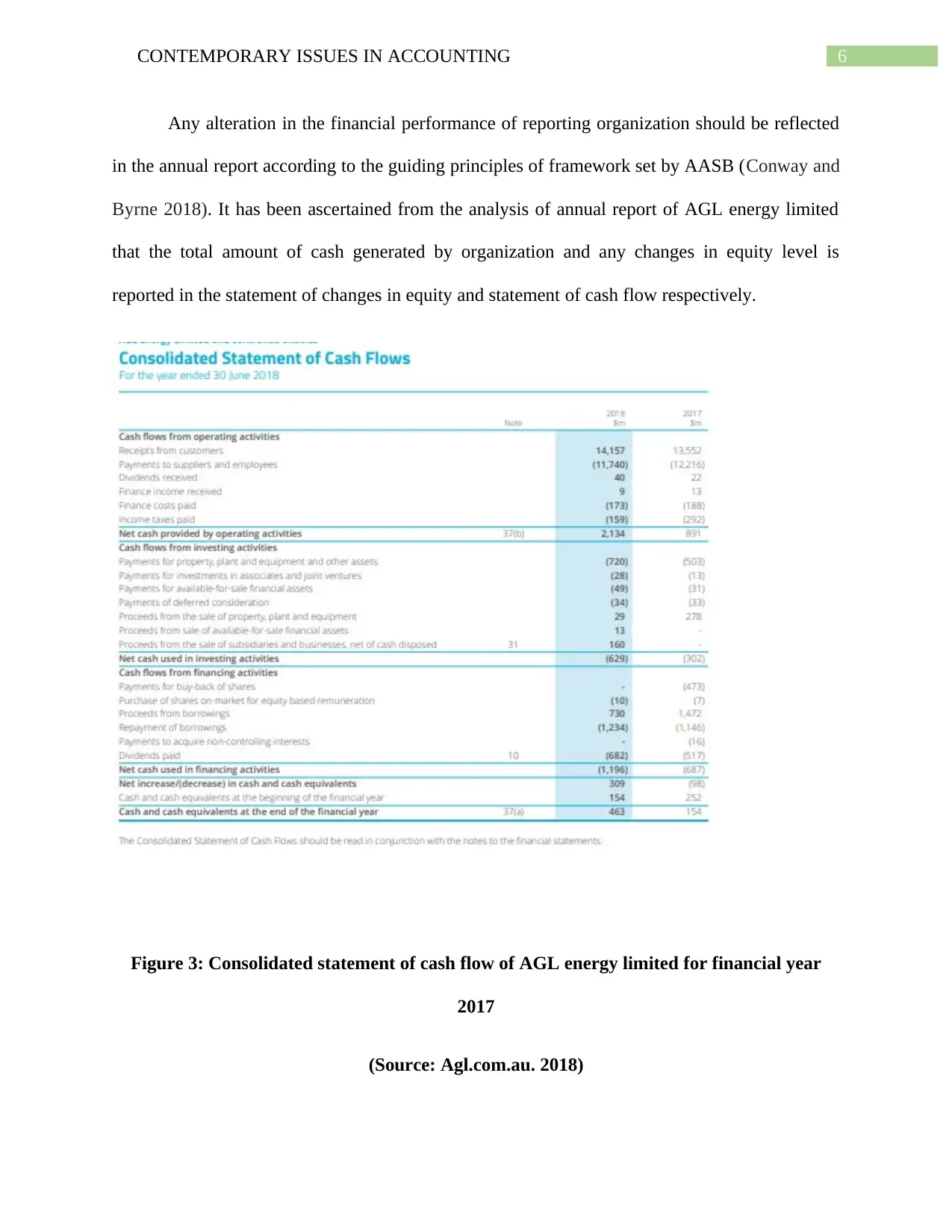
6CONTEMPORARY ISSUES IN ACCOUNTING
Any alteration in the financial performance of reporting organization should be reflected
in the annual report according to the guiding principles of framework set by AASB (Conway and
Byrne 2018). It has been ascertained from the analysis of annual report of AGL energy limited
that the total amount of cash generated by organization and any changes in equity level is
reported in the statement of changes in equity and statement of cash flow respectively.
Figure 3: Consolidated statement of cash flow of AGL energy limited for financial year
2017
(Source: Agl.com.au. 2018)
Any alteration in the financial performance of reporting organization should be reflected
in the annual report according to the guiding principles of framework set by AASB (Conway and
Byrne 2018). It has been ascertained from the analysis of annual report of AGL energy limited
that the total amount of cash generated by organization and any changes in equity level is
reported in the statement of changes in equity and statement of cash flow respectively.
Figure 3: Consolidated statement of cash flow of AGL energy limited for financial year
2017
(Source: Agl.com.au. 2018)
Paraphrase This Document
Need a fresh take? Get an instant paraphrase of this document with our AI Paraphraser
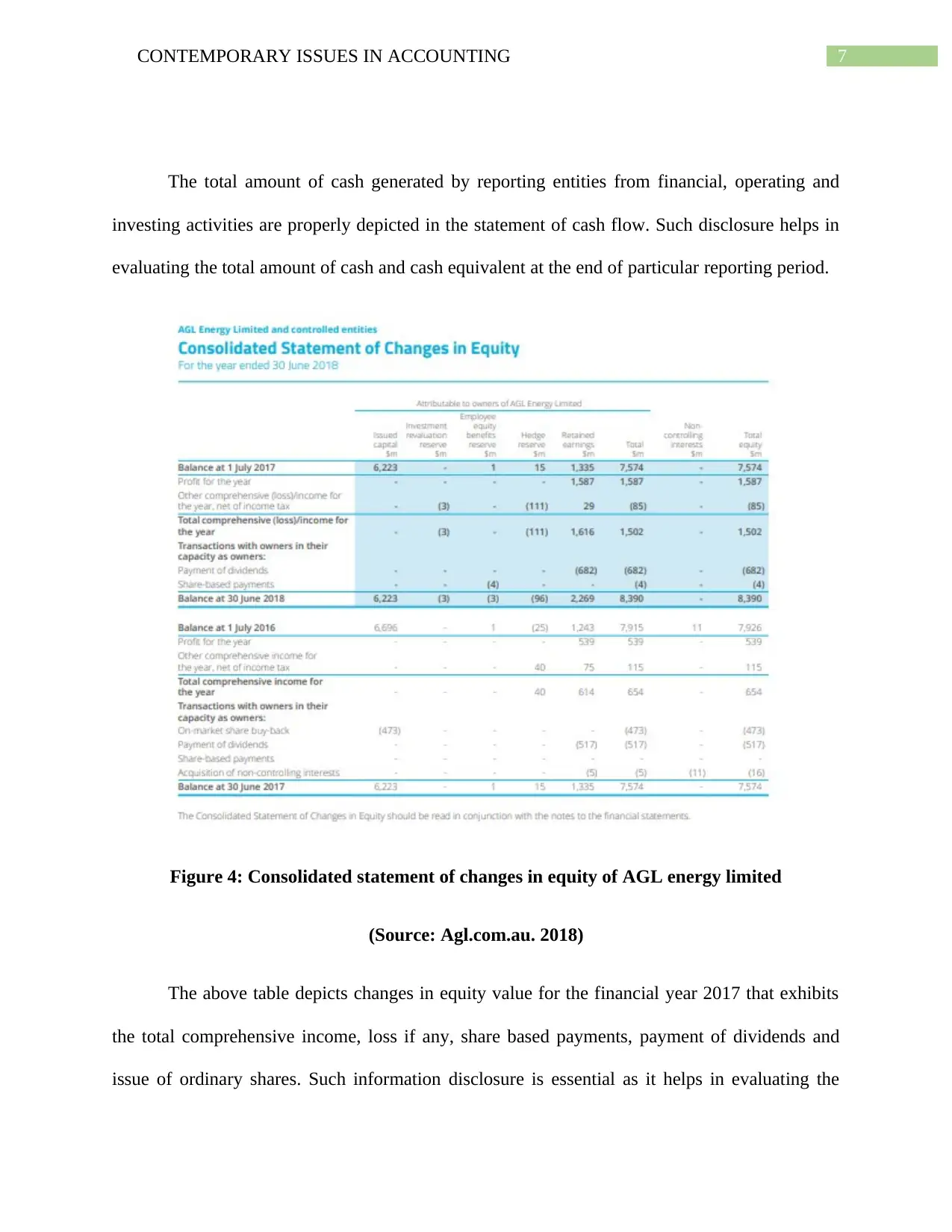
7CONTEMPORARY ISSUES IN ACCOUNTING
The total amount of cash generated by reporting entities from financial, operating and
investing activities are properly depicted in the statement of cash flow. Such disclosure helps in
evaluating the total amount of cash and cash equivalent at the end of particular reporting period.
Figure 4: Consolidated statement of changes in equity of AGL energy limited
(Source: Agl.com.au. 2018)
The above table depicts changes in equity value for the financial year 2017 that exhibits
the total comprehensive income, loss if any, share based payments, payment of dividends and
issue of ordinary shares. Such information disclosure is essential as it helps in evaluating the
The total amount of cash generated by reporting entities from financial, operating and
investing activities are properly depicted in the statement of cash flow. Such disclosure helps in
evaluating the total amount of cash and cash equivalent at the end of particular reporting period.
Figure 4: Consolidated statement of changes in equity of AGL energy limited
(Source: Agl.com.au. 2018)
The above table depicts changes in equity value for the financial year 2017 that exhibits
the total comprehensive income, loss if any, share based payments, payment of dividends and
issue of ordinary shares. Such information disclosure is essential as it helps in evaluating the
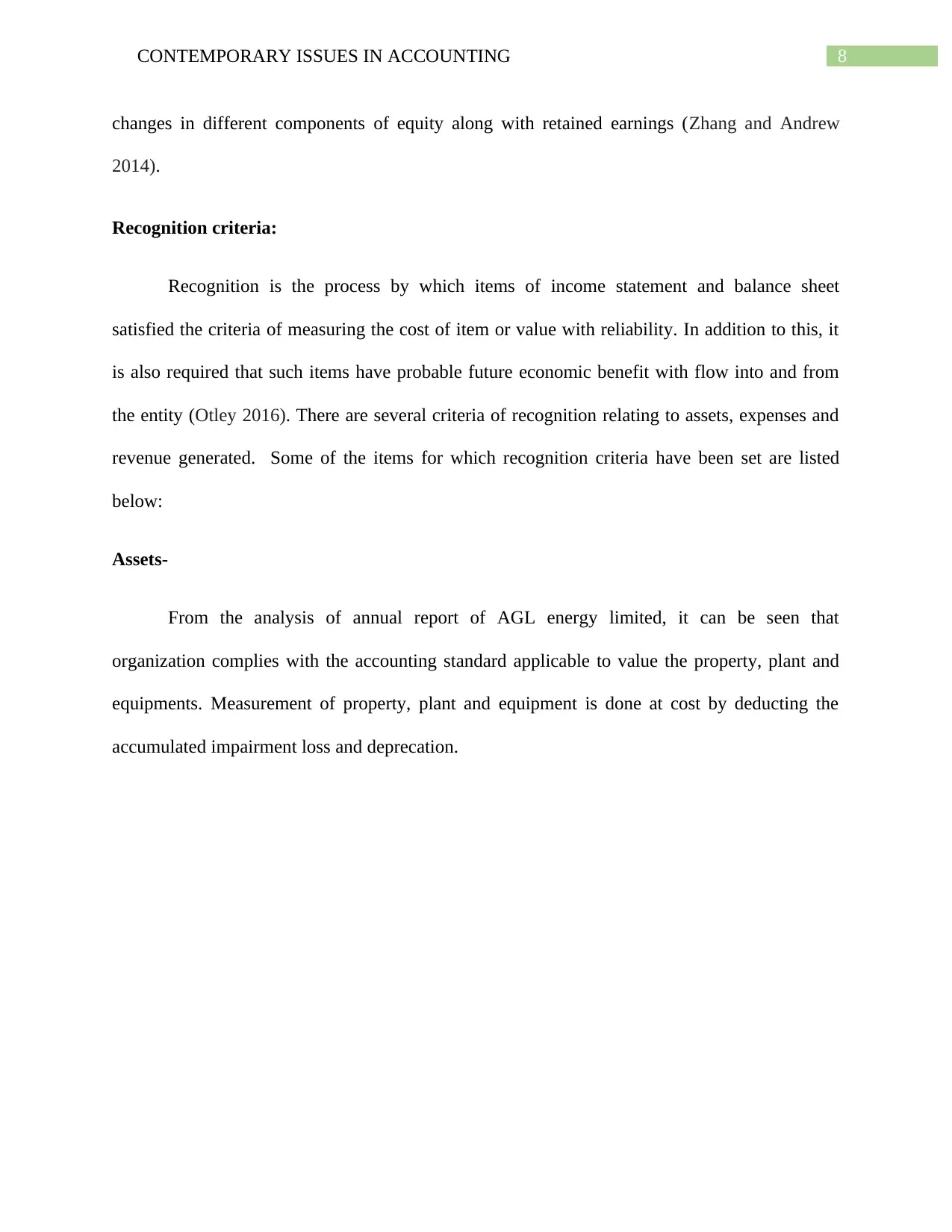
8CONTEMPORARY ISSUES IN ACCOUNTING
changes in different components of equity along with retained earnings (Zhang and Andrew
2014).
Recognition criteria:
Recognition is the process by which items of income statement and balance sheet
satisfied the criteria of measuring the cost of item or value with reliability. In addition to this, it
is also required that such items have probable future economic benefit with flow into and from
the entity (Otley 2016). There are several criteria of recognition relating to assets, expenses and
revenue generated. Some of the items for which recognition criteria have been set are listed
below:
Assets-
From the analysis of annual report of AGL energy limited, it can be seen that
organization complies with the accounting standard applicable to value the property, plant and
equipments. Measurement of property, plant and equipment is done at cost by deducting the
accumulated impairment loss and deprecation.
changes in different components of equity along with retained earnings (Zhang and Andrew
2014).
Recognition criteria:
Recognition is the process by which items of income statement and balance sheet
satisfied the criteria of measuring the cost of item or value with reliability. In addition to this, it
is also required that such items have probable future economic benefit with flow into and from
the entity (Otley 2016). There are several criteria of recognition relating to assets, expenses and
revenue generated. Some of the items for which recognition criteria have been set are listed
below:
Assets-
From the analysis of annual report of AGL energy limited, it can be seen that
organization complies with the accounting standard applicable to value the property, plant and
equipments. Measurement of property, plant and equipment is done at cost by deducting the
accumulated impairment loss and deprecation.
⊘ This is a preview!⊘
Do you want full access?
Subscribe today to unlock all pages.

Trusted by 1+ million students worldwide
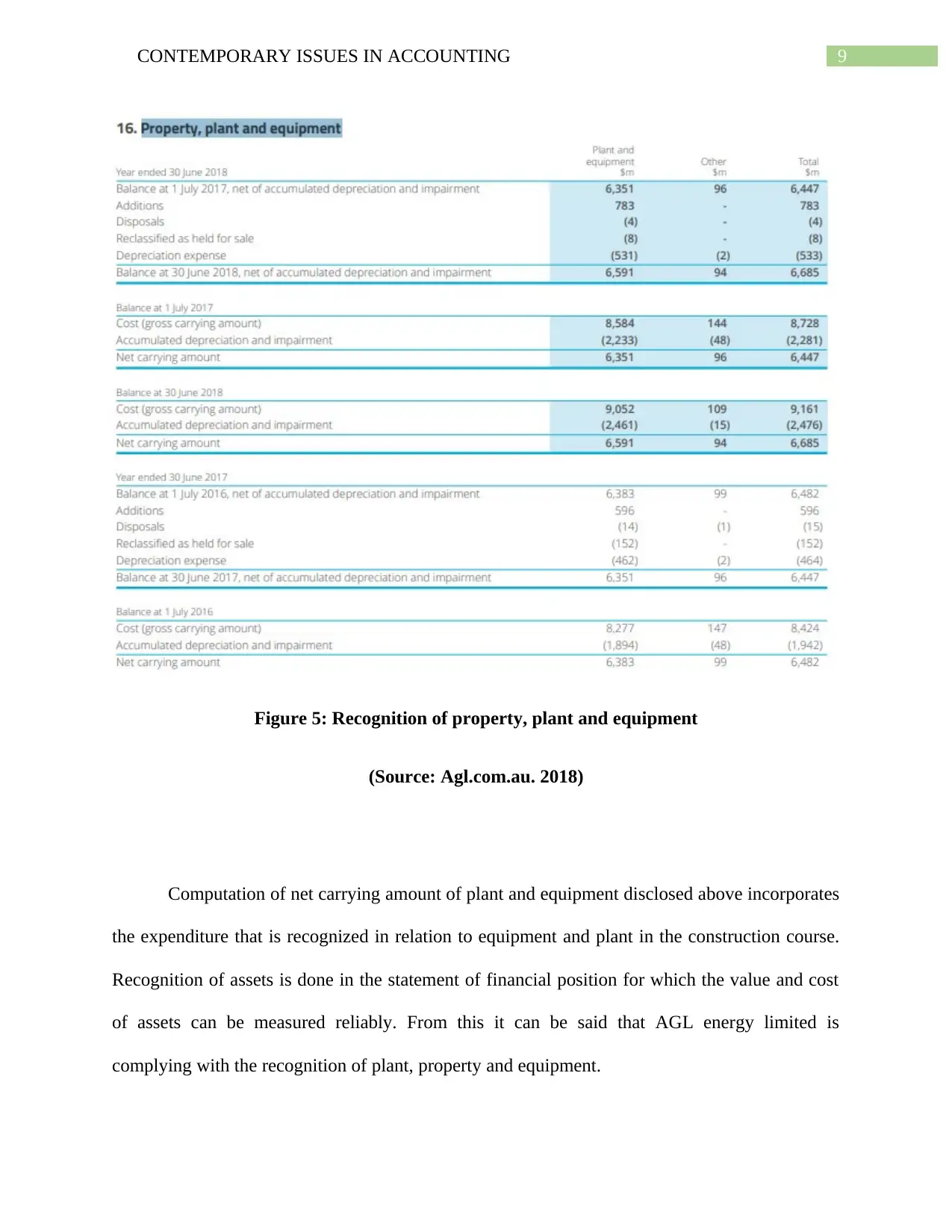
9CONTEMPORARY ISSUES IN ACCOUNTING
Figure 5: Recognition of property, plant and equipment
(Source: Agl.com.au. 2018)
Computation of net carrying amount of plant and equipment disclosed above incorporates
the expenditure that is recognized in relation to equipment and plant in the construction course.
Recognition of assets is done in the statement of financial position for which the value and cost
of assets can be measured reliably. From this it can be said that AGL energy limited is
complying with the recognition of plant, property and equipment.
Figure 5: Recognition of property, plant and equipment
(Source: Agl.com.au. 2018)
Computation of net carrying amount of plant and equipment disclosed above incorporates
the expenditure that is recognized in relation to equipment and plant in the construction course.
Recognition of assets is done in the statement of financial position for which the value and cost
of assets can be measured reliably. From this it can be said that AGL energy limited is
complying with the recognition of plant, property and equipment.
Paraphrase This Document
Need a fresh take? Get an instant paraphrase of this document with our AI Paraphraser
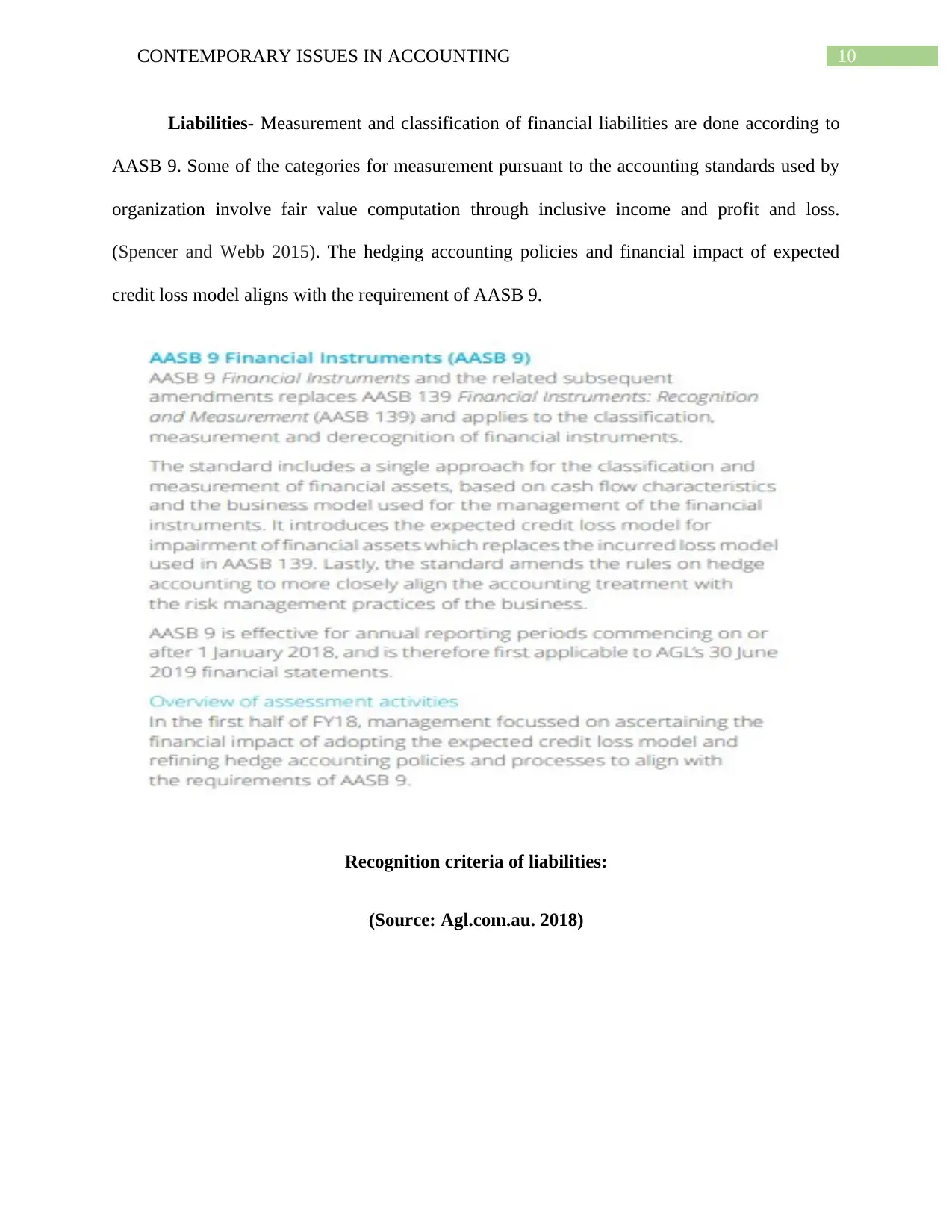
10CONTEMPORARY ISSUES IN ACCOUNTING
Liabilities- Measurement and classification of financial liabilities are done according to
AASB 9. Some of the categories for measurement pursuant to the accounting standards used by
organization involve fair value computation through inclusive income and profit and loss.
(Spencer and Webb 2015). The hedging accounting policies and financial impact of expected
credit loss model aligns with the requirement of AASB 9.
Recognition criteria of liabilities:
(Source: Agl.com.au. 2018)
Liabilities- Measurement and classification of financial liabilities are done according to
AASB 9. Some of the categories for measurement pursuant to the accounting standards used by
organization involve fair value computation through inclusive income and profit and loss.
(Spencer and Webb 2015). The hedging accounting policies and financial impact of expected
credit loss model aligns with the requirement of AASB 9.
Recognition criteria of liabilities:
(Source: Agl.com.au. 2018)
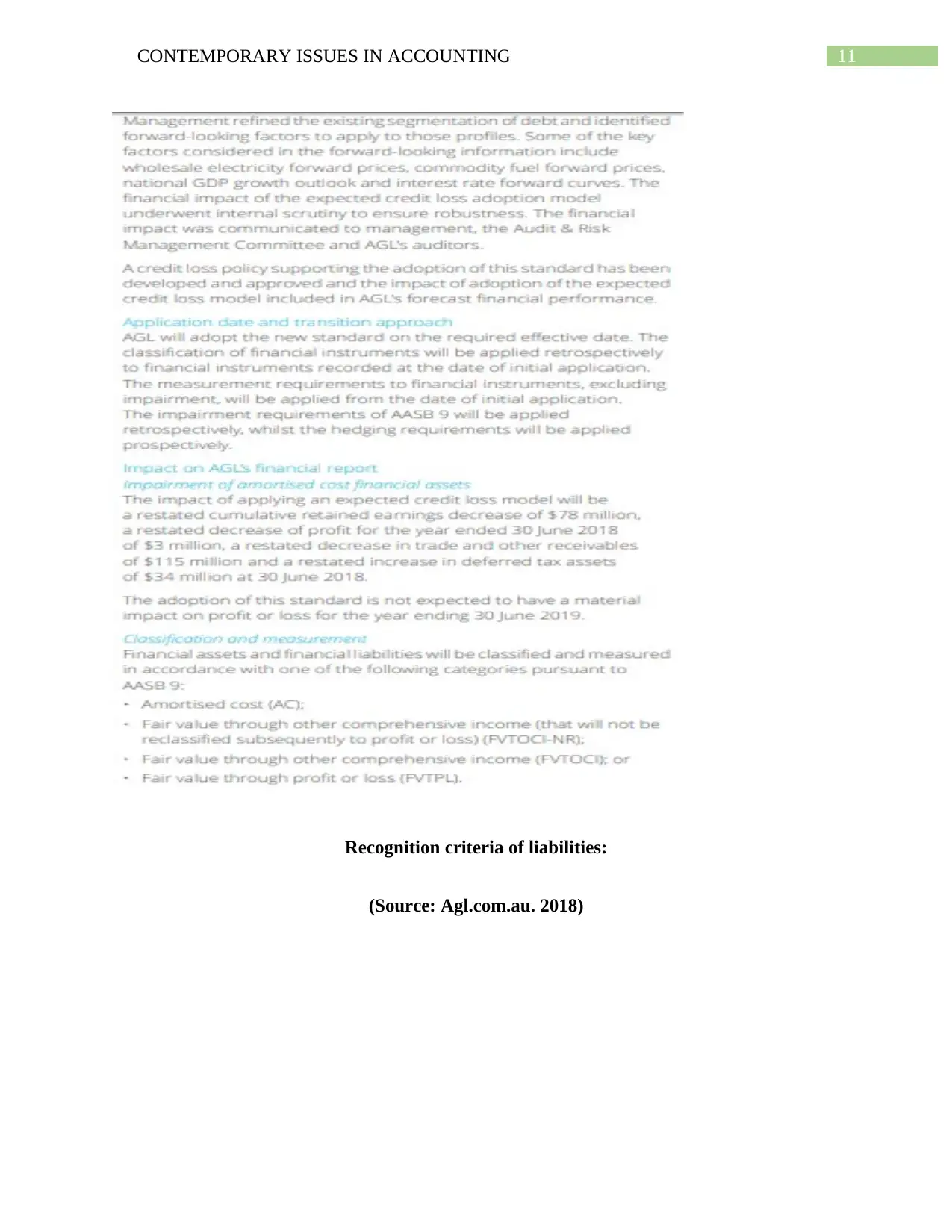
11CONTEMPORARY ISSUES IN ACCOUNTING
Recognition criteria of liabilities:
(Source: Agl.com.au. 2018)
Recognition criteria of liabilities:
(Source: Agl.com.au. 2018)
⊘ This is a preview!⊘
Do you want full access?
Subscribe today to unlock all pages.

Trusted by 1+ million students worldwide
1 out of 17
Related Documents
Your All-in-One AI-Powered Toolkit for Academic Success.
+13062052269
info@desklib.com
Available 24*7 on WhatsApp / Email
![[object Object]](/_next/static/media/star-bottom.7253800d.svg)
Unlock your academic potential
Copyright © 2020–2025 A2Z Services. All Rights Reserved. Developed and managed by ZUCOL.


